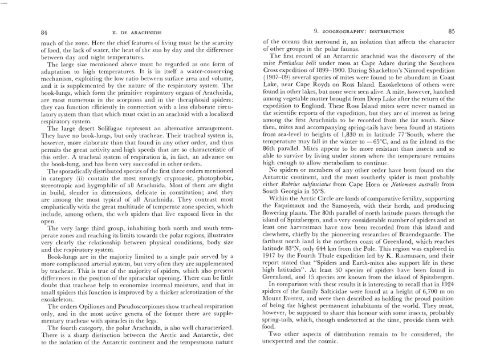Create successful ePaper yourself
Turn your PDF publications into a flip-book with our unique Google optimized e-Paper software.
84 II. DE ARACHNIDIS<br />
much of the zone. Here the chief features of living must be the scarcity<br />
offood, the lack of water, the heat of the sun by day and the difference<br />
between day and night temperatures.<br />
The large size mentioned above must be regarded as one form of<br />
adaptation to high temperatures. It is in itself a water-conserving<br />
mechanism, exploiting the low ratio between surface area and volume,<br />
and it is supplemented by the nature of the respiratory system. The<br />
book-lungs, which form the primitive respiratory organs of <strong>Arachnida</strong>,<br />
are most numerous in the scorpions and in the thcraphosid spiders:<br />
they can function efficiently in connection with a less elaborate circulatory<br />
system than that which must exist in an arachnid with a localized<br />
respiratory system.<br />
The large desert Solifugac represent an alternative arrangement.<br />
They have no book-lungs, but only tracheae. Their tracheal system is,<br />
however, more elaborate than that found in any other order, and thus<br />
permits the great activity and high speeds that are so characteristic of<br />
this order. A tracheal system of respiration is, in fact, an advance on<br />
the book-lung, and has been very successful in other orders.<br />
The sporadically distributed species of the first three orders mentioned<br />
in category (ii) contain the most strongly cryptozoic, photophobic,<br />
stereotropic and hygrophilic of all <strong>Arachnida</strong>. l\Iost of them are slight<br />
in build, slender in dimensions, delicate in constitution; and they<br />
arc among the most typical of all <strong>Arachnida</strong>. They contrast most<br />
emphatically with the great multitude of temperate zone species, which<br />
include, among others, the web spiders that live exposed lives in the<br />
open.<br />
The very large third group, inhabiting both north and south temperate<br />
zones and reaching its limits towards the polar regions, illustrates<br />
very clearly the relationship between physical conditions, body size<br />
and the respiratory system.<br />
Book-lungs are in the majority limited to a single pair served by a<br />
more complicated arterial system, but very often they arc supplemented<br />
by tracheae. This is true of the majority of spiders, which also present<br />
differences in the position of the spiracular opening. There can be little<br />
doubt that tracheae help to economize internal moisture, and that in<br />
small spiders this function is improved by a thicker sclerotization of the<br />
exoskeleton.<br />
The orders Opiliones and Pscudoscorpiones show tracheal respiration<br />
only, and in the most active genera of the former there are supplementary<br />
tracheae with spiracles in the legs.<br />
The fourth category, the polar <strong>Arachnida</strong>, is also well characterized.<br />
There is a sharp distinction between the Arctic and Antarctic, due<br />
to the isolation of the Antarctic continent and the tempestuous nature<br />
9. ZOOGEOGRAPHY: DISTRIBUTION 85<br />
of the oceans that surround it, an isolation that affects the character<br />
of other groups in the polar faunas.<br />
The first record of an Antarctic arachnid was the discovery of the<br />
mite Penthaleus belli under moss at Cape Adare during the Southern<br />
Cross expedition of 1899-1900. During Shackelton's ~imrod expedition<br />
( 1907-09) several species of mites were found to be abundant in Coast<br />
Lake, near Cape Royds on Ross Island. Exoskeletons of others were<br />
found in other lakes, but none were seen alive. A mite, however, hatched<br />
among vegetable matter brought from Deep Lake after the return of the<br />
expedition to England. These Ross Island mites were never named in<br />
the scientific reports of the expedition, but they are of interest as being<br />
among the first <strong>Arachnida</strong> to be recorded from the far south. Since<br />
then, mites and accompanying spring-tails have been found at stations<br />
from sea-level to heights of 1,830 m in latitude 77°South, where the<br />
temperature may fall in the winter to --65°C, and as far inland as the<br />
86th parallel. Mites appear to be more resistant than insects and so<br />
able to survive by living under stones where the temperature remains<br />
high enough to allow metabolism to continue.<br />
No spiders or members of any other order have been found on the<br />
Antarctic continent, and the most southerly spider is most probably<br />
either Rubrius subfasciatus from Cape Horn or Notiomaso australis from<br />
South Georgia in 55°S.<br />
Within the Arctic Circle are lands of comparative fertility, supporting<br />
the Esquimaux and the Samoyeds, with their herds, and producing<br />
flowering plants. The 80th parallel of north latitude passes through the<br />
island of Spitzbergen, and a very considerable number of spiders and at<br />
least one harvestman have now been recorded from this island and<br />
elsewhere, chiefly by the pioneering researches of Braendegaarde. The<br />
farthest north land is the northern coast of Greenland, which reaches<br />
latitude 83°N, only 644 km from the Pole. This region was explored in<br />
1917 by the Fourth Thule expedition led by K. Rasmussen, and their<br />
report stated that "Spiders and Earth-mites also support life in these<br />
high latitudes". At least 50 species of spiders have been found in<br />
Greenland, and 15 species are known from the island of Spitzbergen.<br />
In comparison with these results it is interesting to recall that in 1924<br />
spiders of the family Salticidae were found at a height of 6, 700 m on<br />
Mount Everest, and were then described as holding the proud position<br />
of being the highest permanent inhabitants of the world. They must,<br />
however, be supposed to share this honour with some insects, probably<br />
spring-tails, which, though undetected at the time, provide them with<br />
food.<br />
Two other aspects of distribution remain to be considered, the<br />
unexpected and the cosmic.















